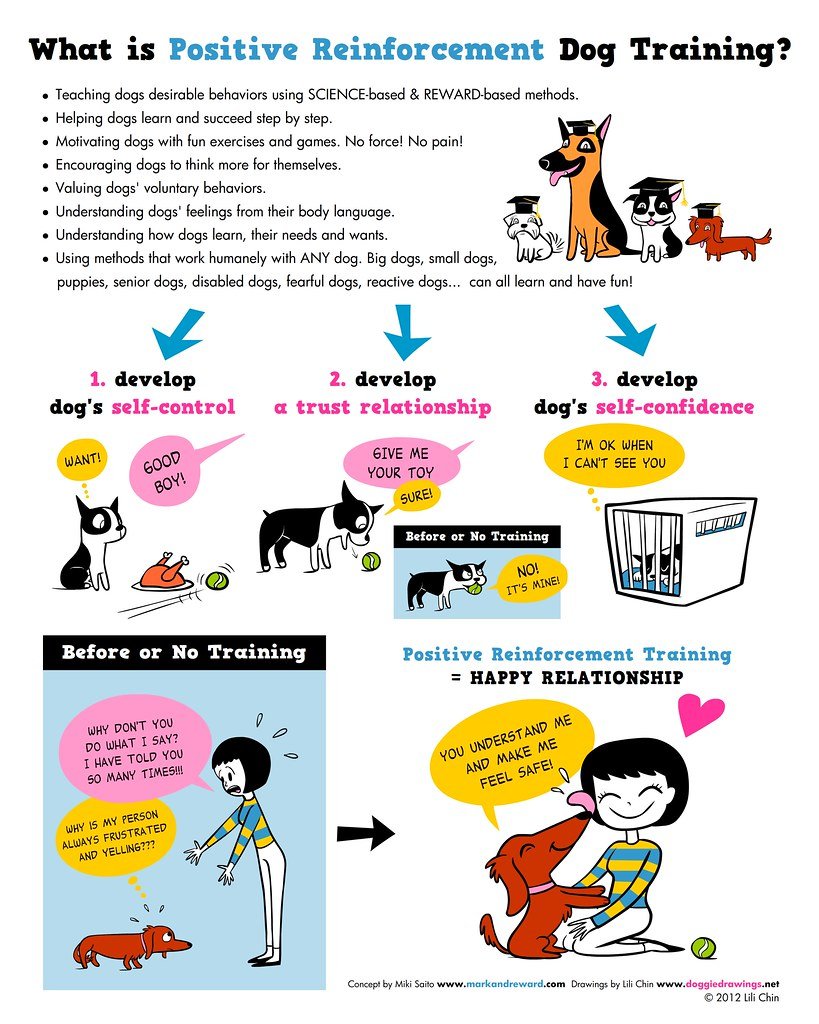Dogs, oh glorious dogs! Our faithful, tail-wagging companions, ever ready to shower us with love and unwavering loyalty. Yet, there are times, amidst the cacophony of woofs and barks, when we yearn for a moment of tranquility. A peaceful respite from the persistent yapping that threatens our sanity, and the neighbors’ blissful silence. Fear not, dear dog owners, for we bring you the secret to serenity – the mystical power of the “hush” command. In this whimsical realm of doggy obedience, we shall embark upon an enchanting journey to silence with our furry friends, discovering the methods to keep their woofs at bay. So, buckle up, dog-lovers, for in this mystical universe of unruffled canines, silence shall reign supreme, one “hush” at a time.
Table of Contents
- Mastering the Art of Silence: Teaching Your Furry Friend the “Hush” Command
- Creating a Calm Environment: Setting the Stage for Successful Training
- The Power of Positive Reinforcement: Using Rewards to Encourage Quiet Behavior
- Timing is Key: Practicing Patience and Consistency in Teaching “Hush”
- Breaking the Habit: Addressing Excessive Barking with Proper Training
- Q&A
- Closing Remarks

Mastering the Art of Silence: Teaching Your Furry Friend the “Hush” Command
Are you tired of your furry friend barking incessantly? Do you find yourself longing for moments of peaceful tranquility? If so, it’s time to master the art of silence and teach your beloved pet the “Hush” command. This command can be a lifesaver when you have guests over or simply want some quiet time to yourself.
To successfully teach your furry companion the “Hush” command, remember to:
- Be patient: Patience is key when training any command. Some dogs may pick up on the command quickly, while others may require more time and practice. Remain calm and consistent throughout the training process.
- Use positive reinforcement: Always reward your pet for obeying the “Hush” command. Whether it’s a treat, praise, or a belly rub, positive reinforcement helps reinforce the desired behavior.
- Start in a quiet environment: Begin the training in a quiet space with minimal distractions. This allows your furry friend to focus solely on learning the command without being overwhelmed.
Remember, consistency is key when teaching your pet the “Hush” command. With time and dedication, you’ll be able to enjoy peaceful moments together and create a harmonious living environment for everyone.

Creating a Calm Environment: Setting the Stage for Successful Training
In order to ensure successful training sessions, it is crucial to create a calm and supportive environment for both the trainer and the trainee. By setting the right stage, you can enhance focus, reduce distractions, and encourage effective learning. Here are some tips to help you create a harmonious atmosphere for your training sessions:
- Organize the physical space: Arrange the training area in a way that promotes comfort and concentration. Ensure that the space is clean, well-lit, and free from clutter or unnecessary distractions. Providing comfortable seating, suitable lighting, and a temperature-controlled environment can significantly contribute to a calm atmosphere.
- Establish clear expectations: Communicate the training objectives and expectations to the participants upfront. Setting clear guidelines and rules will help create a sense of structure and order. Encourage participants to actively engage in the training, ask questions, and express their opinions.
- Utilize calming techniques: Incorporate relaxation exercises or mediation techniques at the beginning or during breaks to help participants unwind and focus. Deep breathing exercises, stretching, or guided visualizations can help reduce stress levels and create a serene environment conducive to learning.
Remember, a calm environment acts as a catalyst for effective training. By proactively prioritizing serenity, you set the stage for a successful and enriching learning experience.

The Power of Positive Reinforcement: Using Rewards to Encourage Quiet Behavior
As parents, educators, or managers, we often find ourselves in the position of needing to encourage quiet behavior in others. One powerful tool we can utilize is positive reinforcement through the use of rewards. By implementing a system of rewards for quiet behavior, we not only motivate individuals to behave quietly, but also create an environment that fosters a calm and focused atmosphere.
Rewards can take many forms, from simple tokens or stickers for younger children, to points or privileges for older ones. By clearly defining the desired behavior and establishing a reward system, individuals will be more inclined to exhibit quiet behavior in order to earn the associated rewards. This approach not only reinforces the positive behavior but also provides an incentive for others to emulate the desired quiet behavior.
Moreover, the power of positive reinforcement extends beyond immediate behavioral changes. When individuals consistently receive rewards for quiet behavior, they develop a positive association with being quiet, making it more likely for them to exhibit quiet behavior in the future, even without incentives. This long-term change fosters a culture of quietness and can lead to improved concentration, learning, and overall productivity.
- Create a clear system: Clearly define the expectations and parameters of quiet behavior, and explain the reward system to all individuals involved.
- Choose suitable rewards: Tailor the rewards to the age group and preferences of the individuals involved, ensuring they are motivating and meaningful.
- Consistency is key: Consistently reinforce quiet behavior with rewards to establish a positive association with this desired behavior.
- Gradually decrease dependence on rewards: Over time, gradually reduce the frequency of rewards, helping individuals transition to exhibiting quiet behavior without the need for constant incentives.
In conclusion, the power of positive reinforcement through the use of rewards is a valuable tool for encouraging quiet behavior. By implementing a clear system and consistently rewarding individuals for being quiet, we create an environment that emphasizes the importance of calmness and focus. This approach not only motivates individuals in the short term but also cultivates a long-term change in behavior, leading to improved concentration, learning, and overall productivity.

Timing is Key: Practicing Patience and Consistency in Teaching “Hush”
In the vibrant world of teaching, the ability to strike the perfect timing when imparting knowledge is an art that every educator aspires to master. In the case of teaching the cherished technique of “Hush,” this art becomes even more crucial. Encouraging students to embrace the power of silence through their movements is no mean feat, but with patience and consistency, remarkable outcomes can be achieved.
One of the fundamental aspects of practicing patience in teaching “Hush” lies in allowing students the time to internalize and embody the essence of tranquility. Like nurturing a seed, this technique requires careful cultivation. By providing a safe space where students can explore their own pace and discover the subtle nuances of stillness, their confidence in executing the technique will flourish.
Consistency acts as a guiding force throughout the journey of teaching “Hush.” By utilising consistent cues, reminders, and gentle corrections, educators can establish a solid framework for students to follow, ultimately strengthening their understanding and execution. Incorporating visual aids, such as demonstration videos or diagrams, can further enhance consistency and help students visualize and decode the intricacies of this mesmerizing technique.
Breaking the Habit: Addressing Excessive Barking with Proper Training
Barking is a natural behavior for dogs, but excessive barking can be a nuisance and even a source of tension between owners and their furry companions. However, with proper training and understanding, it’s possible to break the habit of excessive barking and restore peace to your home.
Understanding the Root Cause
Before addressing excessive barking, it’s important to identify the root cause. Dogs may bark excessively due to boredom, anxiety, fear, territorial behavior, or a need for attention. By observing their body language and listening to the context of their barks, you can gain insight into the underlying reasons behind their excessive vocalizations.
Positive Reinforcement and Redirecting Behavior
Training plays a crucial role in helping dogs break the habit of excessive barking. Instead of scolding or punishing your furry friend, focus on positive reinforcement techniques. Use treats, praise, and rewards to reinforce calm behavior and redirect their attention to more appropriate activities. Whether it’s providing stimulating toys, engaging in regular exercise, or teaching them commands like “quiet” or “speak,” positive reinforcement training can help rewire their barking habits.
Seeking Professional Guidance
If you find yourself struggling to address your dog’s excessive barking despite your best efforts, don’t hesitate to seek professional guidance. A certified dog trainer or behaviorist can offer specialized techniques and in-depth knowledge that may prove invaluable in breaking the habit. With their expertise, they can tailor a training plan specific to your dog’s needs, ensuring a long-term solution to excessive barking.
Q&A
How can I teach my dog the “hush” command?
To teach your dog the “hush” command, start by waiting for a moment when they are barking. Firmly say “hush” and hold a treat close to their nose. Once they stop barking, reward them with the treat and praise. Repeat this process until they associate the “hush” command with silence.
What should I do if my dog does not respond to the “hush” command?
If your dog doesn’t respond to the “hush” command, remain patient and consistent. Continue practicing the command in different situations and reward them for any signs of improvement. If the issue persists, consult a professional dog trainer for additional guidance.
Is it possible to teach an older dog the “hush” command?
Yes! Although it may take more time and effort, older dogs can still learn the “hush” command. Be patient and consistent with your training, using positive reinforcement and rewards. Remember that every dog is different, and it might take longer for some to grasp the command.
What should I avoid when training my dog to be quiet?
Avoid yelling, harsh physical punishments, or startling tactics when trying to train your dog to be quiet. Such actions could lead to fear or aggression. Instead, focus on positive reinforcement and reward-based training to create a calm and safe learning environment for your furry friend.
Are there any other methods to help keep my dog quiet?
In addition to teaching the “hush” command, ensure that your dog’s physical and mental needs are met. Regular exercise, mental stimulation, and keeping them engaged with toys can help alleviate boredom and reduce excessive barking. If the problem persists, consult with a professional dog behaviorist for further guidance.
Can the “hush” command be used in all situations?
The “hush” command can be effective in many situations, but it may not work in every scenario. For example, if your dog is barking due to fear or anxiety, it’s essential to address the underlying cause before expecting the “hush” command to be effective. Understanding your dog’s behavior and individual needs is crucial for successful training.
Closing Remarks
In a world filled with barks and howls, the “Hush” command emerges as a gentle symphony to soothe the restless souls of our four-legged friends. As we journeyed through the realms of canine communication, we unraveled the secrets of maintaining serenity in the presence of our beloved dogs. By mastering the art of the “Hush” command, we have discovered a tool capable of harmonizing our homes and hearts.
Remember, a quiet dog is not a silenced dog, but rather a tranquil spirit enjoying the serenity of the moment. With patience, consistency, and a sprinkle of creativity, you too can guide your furry companion toward inner peace using this powerful command. Whether you wish to silence the uproar during a late-night phone call or halt their never-ending chorus when the mailman visits, the “Hush” command holds the key.
Throughout this journey, we have learned that understanding our dogs’ needs and responding to them compassionately is essential. Rather than suppressing their natural inclination to communicate, we can gently redirect their energy and focus, forging a deeper bond built on trust and harmony.
As the sun sets on this exploration of the “Hush” command, let us embark on a new chapter—one where howls are replaced by moments of calm. You, dear reader, now hold the tools to orchestrate harmony, and it is with great delight that we entrust you with this newfound knowledge.
May your days be filled with wagging tails, soulful glances, and the occasional “Hush,” a testament to the delicate dance of hushed communication between human and canine. Embrace this newfound power responsibly, and remember, an oasis of tranquility awaits you if you dare to take the first step with the power of the “Hush” command.
As an affiliate, my content may feature links to products I personally use and recommend. By taking action, like subscribing or making a purchase, you’ll be supporting my work and fueling my taco cravings at the same time. Win-win, right?
Want to read more? Check out our Affiliate Disclosure page.